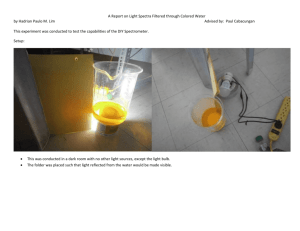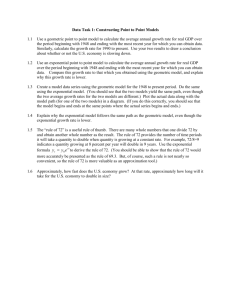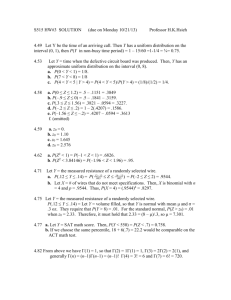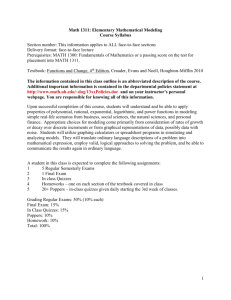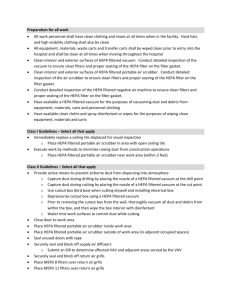MichelleWest-Drug Filtering and Exponential Decay
advertisement
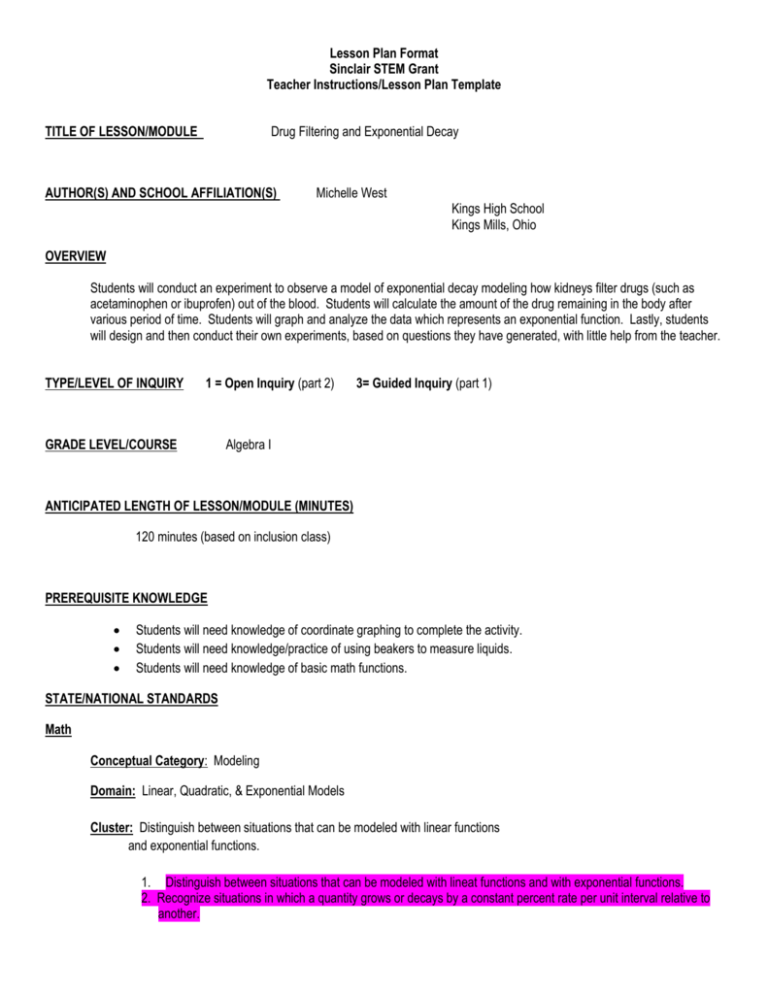
Lesson Plan Format Sinclair STEM Grant Teacher Instructions/Lesson Plan Template TITLE OF LESSON/MODULE Drug Filtering and Exponential Decay AUTHOR(S) AND SCHOOL AFFILIATION(S) Michelle West Kings High School Kings Mills, Ohio OVERVIEW Students will conduct an experiment to observe a model of exponential decay modeling how kidneys filter drugs (such as acetaminophen or ibuprofen) out of the blood. Students will calculate the amount of the drug remaining in the body after various period of time. Students will graph and analyze the data which represents an exponential function. Lastly, students will design and then conduct their own experiments, based on questions they have generated, with little help from the teacher. TYPE/LEVEL OF INQUIRY 1 = Open Inquiry (part 2) GRADE LEVEL/COURSE 3= Guided Inquiry (part 1) Algebra I ANTICIPATED LENGTH OF LESSON/MODULE (MINUTES) 120 minutes (based on inclusion class) PREREQUISITE KNOWLEDGE Students will need knowledge of coordinate graphing to complete the activity. Students will need knowledge/practice of using beakers to measure liquids. Students will need knowledge of basic math functions. STATE/NATIONAL STANDARDS Math Conceptual Category: Modeling Domain: Linear, Quadratic, & Exponential Models Cluster: Distinguish between situations that can be modeled with linear functions and exponential functions. 1. Distinguish between situations that can be modeled with lineat functions and with exponential functions. 2. Recognize situations in which a quantity grows or decays by a constant percent rate per unit interval relative to another. 3. Observe using graphs and tables that a quantity increasing exponentially eventually exceeds a quantity increasing linearly, quadratically, or (more generally) as a polynomial function. MATERIALS : Clear 2 liter pitchers 250 ml beaker Spoons for mixing Water Food coloring Container to discard colored water if you don’t have access to a sink in your room. Calculator INSTRUCTIONAL PLAN PART I A. INTRODUCTION Begin by informing the students that today they will be modeling how the body’s kidneys filter blood. Explain that they will be using water to represent the blood and food coloring to represent our drug that needs filtered. During the first part of this activity students will be in groups however we will all be conducting the experiment at the same time. Questions you might address in this section Did you ever wonder how long medicine stays in your body? Do you think that all substances are filtered at the same rate? About how much blood do you have in your body? B. ACTIVITY Pour 1 liter of water into a pitcher representing blood. Put 4 drops of food coloring into the water representing 1000mg of acetaminophen. Mix the food coloring well with the water. Take out 25% of the drug (250 ml) and discard it. Replace it with 250ml of clear water. Discuss with students how many milligrams of the drug remain in the blood. Ask students how the kidney’s work could be modeled after another 4 hours. Have students remove another 250 ml of colored water and discard it. Replace it with 250ml of clear water. Ask students how much of the drug remains in the blood. Many students say 500 ml. If this occurs I then inquire that if I do this 4 times will the drug be completely out of my system? Take 250 ml of colored water and discard it. Replace it with 250ml of clear water. Ask students that if you did this one more time would the water be clear? Discuss with students whether it was the model or the prediction that was incorrect. Make sure that students understand that the second time you removed the 250 ml of colored water that there was only 750mg of the drug remaining. So ¼ * 750 = 187.5mg were removed the second time. Pass out Drug Filtering Activity Sheet and have students complete with their partner/group. C. POST ACTIVITY DISCUSSION Discuss with students if the graph representing this situation is a linear graph. Explain that it is not because the same amount of the drug is not filtered out during each four hour period. Have students look at their graphs and explain that this graph represents exponential decay. Ask students how they would describe the amount of the drug in your blood as time goes on. Do they think the drug will ever be completely out of their body? Do all things leave your body this way? PART 2 A. INTRODUCTION Discuss with students if what they originally thought would happen actually occurred. In other words, was their hypothesis correct? Discuss sources of error for the experiment. Was there a control for the experiment? Everyone began with the same amount of drug 1000mg and filtered 25% every 4 hours. Would we get similar results if had different initial conditions? In groups students will be given a die. If they roll a 1 they must change one condition from the original experiment, a 2 they must change two conditions and a 3 they have to change all three conditions (dose, percent filtered, and time filtered). Students will chart and graph their findings. B. ACTIVITY Students will roll a die to determine how many of the original conditions will be changed. Each student is then to generate a chart and graph using their new conditions. Students will then be paired with another group and asked to share/compare their data and graphs. Each group (2-3 students) will be asked to share their graph with the class C. POST ACTIVITY DISCUSSION Students will discuss similarities/differences about the graphs. EXTENSIONS Students can use graphing calculators or graphing software on laptops to display data. Students can write equations to model the situation. ASSESSMENT Students will complete a post experiment paper. Included in this assessment, students will write a reflective paragraph describing sources of error and noting any changes that they would make. REFERENCES Illuminations, 2000-2013. Web. 27 July 2013. <http://illuminations.nctm.org/LessonDetail.aspx?id=L829> SAFETY CONSIDERATIONS Make sure students are not allergic the dye and that they have “older” clothes on as the food coloring stains. Drug Filtering NAME ________________________ 1. Assume that your kidneys can filter out 25% of a drug in your blood every 4 hours. You take one 1000-milligram dose of the drug. Fill in the table showing the amount of the drug in your blood as a function of time. The first two data points are already completed. Round each value to the nearest milligram.


